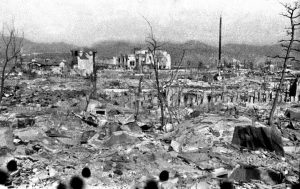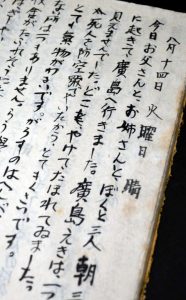Documenting Hiroshima of 1945: August 14, entering Hiroshima from evacuation site, boy writes in journal, “Everything was burned to the ground”
Aug. 14, 2024
by Kyosuke Mizukawa, Senior Staff Writer
On August 14, 1945, Fumio Takamasu, nine at the time, who died in 2015 at the age of 79, entered Hiroshima City from the area of Yoshida-cho (in the city’s present-day Akitakata City), Hiroshima Prefecture, the location to which his family had been evacuated. Eight days after the atomic bombing, they had set out to check on the condition of the school where his father worked as well as of their house.
Mr. Takamasu wrote in his journal entry on August 14, “Today, my father, older sister, and I woke up at 3 a.m. and went to Hiroshima.” Arriving at Hiroshima Station, about 1.9 kilometers from the hypocenter, they found that the surrounding area had been incinerated. He wrote, “Everything was burned to the ground … there was no place without fallen shards of glass.”
trong>Clumps of blood in schoolyard trong>
Keiso Takamasu, Fumio’s father, was a Japanese-style painter with the actual first name of “Keizo” who died in 1985 at the age of 84. Losing his hearing as a child, he studied Japanese-style painting and worked as a fine arts instructor at the Prefectural School for the Deaf (present-day Hiroshima Minami Special Needs School, in the city’s Naka Ward). Fumio wrote, “The school building was on the verge of collapse … there were clumps of blood in the schoolyard.” The school, located in the area of Yoshijima-honmachi (in present-day Naka Ward), around 2.7 kilometers from the hypocenter, had been damaged by the A-bomb’s blast.
According to the publication Hiroshima Ro Gakko, Hibaku to Sokai no Kiroku (in English, ‘The Prefectural School for the Deaf: Records of the atomic bombing and evacuation’), a collection of testimonies from former staff members that was published in 1996, the school building’s pillars were broken and the building tilted, while the school dormitory was also partially destroyed. As both buildings had been spared the spreading flames, they were used as evacuation sites for many people wounded in the bombing. Earlier in April, the school had been relocated to the area of Yoshida-cho, with the teaching staff and students also evacuated there. However, some of the students had stayed in the city and were killed in the atomic bombing.
trong>Radioactive remains trong>
As with Mr. Takamasu’s family, many people who entered the city to check on their workplaces or houses were exposed to A-bomb radiation. Records of residual radiation measurements taken during that time in various parts of the city still exist. Motoharu Kimura, who died in 1996 at the age of 87, and other researchers at the Institute of Physical and Chemical Research (Riken), a pioneering organization in atomic physics research in Japan with head offices in Tokyo, were involved in the measurement work.
On August 10, Mr. Kimura confirmed the presence of radiation in copper wires that had been sent by air under the direction of Yoshio Nishina, a scientist that had entered Hiroshima on August 8 accompanying an Imperial General Headquarters survey team. To conduct more thorough research, nine specialists including Mr. Kimura headed to the city with a device designed to measure radiation, arriving at Hiroshima Station on August 14.
On the first day, the group examined the remains on Ninoshima Island (in Hiroshima’s present-day Minami Ward), to which many wounded people had been taken. Those examinations were conducted because the bones were believed to indicate strong radioactivation, with the phosphorus in bones having absorbed neutrons released by the atomic bombing.
Mr. Kimura wrote in his journal entry the following morning, August 15, “We measured bones in a laboratory on Ninoshima Island in the afternoon and discovered that a skull of someone who died on the island had about 10 times the activity of natural rates.”
From August 15 to 17, the group went around Hiroshima in a car with the measurement device. They were able to confirm radioactivity “five times stronger than natural levels” (according to a report made at the time) at the entrance to the West Drill Ground, located near the present-day prefectural offices. To the west side of that area, in the vicinity of Hiroshima Gokoku Shrine and elsewhere, radiation levels were also higher than natural background rates. That area was close to the hypocenter, which is the spot directly below the A-bomb detonation.
(Originally published on August 14, 2024)
On August 14, 1945, Fumio Takamasu, nine at the time, who died in 2015 at the age of 79, entered Hiroshima City from the area of Yoshida-cho (in the city’s present-day Akitakata City), Hiroshima Prefecture, the location to which his family had been evacuated. Eight days after the atomic bombing, they had set out to check on the condition of the school where his father worked as well as of their house.
Mr. Takamasu wrote in his journal entry on August 14, “Today, my father, older sister, and I woke up at 3 a.m. and went to Hiroshima.” Arriving at Hiroshima Station, about 1.9 kilometers from the hypocenter, they found that the surrounding area had been incinerated. He wrote, “Everything was burned to the ground … there was no place without fallen shards of glass.”
Keiso Takamasu, Fumio’s father, was a Japanese-style painter with the actual first name of “Keizo” who died in 1985 at the age of 84. Losing his hearing as a child, he studied Japanese-style painting and worked as a fine arts instructor at the Prefectural School for the Deaf (present-day Hiroshima Minami Special Needs School, in the city’s Naka Ward). Fumio wrote, “The school building was on the verge of collapse … there were clumps of blood in the schoolyard.” The school, located in the area of Yoshijima-honmachi (in present-day Naka Ward), around 2.7 kilometers from the hypocenter, had been damaged by the A-bomb’s blast.
According to the publication Hiroshima Ro Gakko, Hibaku to Sokai no Kiroku (in English, ‘The Prefectural School for the Deaf: Records of the atomic bombing and evacuation’), a collection of testimonies from former staff members that was published in 1996, the school building’s pillars were broken and the building tilted, while the school dormitory was also partially destroyed. As both buildings had been spared the spreading flames, they were used as evacuation sites for many people wounded in the bombing. Earlier in April, the school had been relocated to the area of Yoshida-cho, with the teaching staff and students also evacuated there. However, some of the students had stayed in the city and were killed in the atomic bombing.
As with Mr. Takamasu’s family, many people who entered the city to check on their workplaces or houses were exposed to A-bomb radiation. Records of residual radiation measurements taken during that time in various parts of the city still exist. Motoharu Kimura, who died in 1996 at the age of 87, and other researchers at the Institute of Physical and Chemical Research (Riken), a pioneering organization in atomic physics research in Japan with head offices in Tokyo, were involved in the measurement work.
On August 10, Mr. Kimura confirmed the presence of radiation in copper wires that had been sent by air under the direction of Yoshio Nishina, a scientist that had entered Hiroshima on August 8 accompanying an Imperial General Headquarters survey team. To conduct more thorough research, nine specialists including Mr. Kimura headed to the city with a device designed to measure radiation, arriving at Hiroshima Station on August 14.
On the first day, the group examined the remains on Ninoshima Island (in Hiroshima’s present-day Minami Ward), to which many wounded people had been taken. Those examinations were conducted because the bones were believed to indicate strong radioactivation, with the phosphorus in bones having absorbed neutrons released by the atomic bombing.
Mr. Kimura wrote in his journal entry the following morning, August 15, “We measured bones in a laboratory on Ninoshima Island in the afternoon and discovered that a skull of someone who died on the island had about 10 times the activity of natural rates.”
From August 15 to 17, the group went around Hiroshima in a car with the measurement device. They were able to confirm radioactivity “five times stronger than natural levels” (according to a report made at the time) at the entrance to the West Drill Ground, located near the present-day prefectural offices. To the west side of that area, in the vicinity of Hiroshima Gokoku Shrine and elsewhere, radiation levels were also higher than natural background rates. That area was close to the hypocenter, which is the spot directly below the A-bomb detonation.
(Originally published on August 14, 2024)









